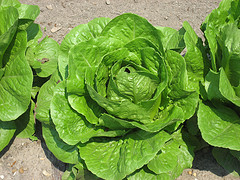Lettuce
| Infobox on Lettuce | |
|---|---|
| Example of Lettuce |  |
| Freshness facts | |
| Optimum carrying temperature | 0°C |
| Highest freezing point | -0,2°C |
| Acceptable product temp. at loading into containers | Max. 2°C above carrying temperature |
| Optimum humidity | 95% to 100% |
| Ventilation setting for containers | 50 m³/hr |
| Storage life | 1 to 4 weeks |
| Climacteric / non-climacteric | Non-climacteric |
| Ethylene production | Low |
| Ethylene sensitivity | High |
| Modified / controlled atmosphere | 1% to 3% O2; 0% CO2 |
| Potential benefits | See text |
| Availability | |
| On demand | |
Lettuce
Contents
Harvesting and Handling
The four distinct types of lettuce produced are crisphead or iceberg, butterhead, cos (or romaine) and leaf.
Crisphead lettuce produces large, heavy, compact folded heads with crisp, brittle, prominently veined leaves. Butterhead lettuce form open heads with softer leaves having a smooth texture. Cos lettuce does not form a true head, but is composed of upright, large, elongated and often coarser leaves. Leaf lettuce also does not produce a head, and the leaves are more spreading, delicate, smaller and less elongate than cos.
Crisphead lettuce is best adopted for long distance shipment. A greater percentage of all types of lettuce are being processed into fresh-cut salad mixes for commercial and home use. With proper vacuum cooling and packaging, refrigerated transportation under controlled atmospheres can supply whole and packaged lettuces to national and international markets.
Head lettuce is harvested when the heads are well formed and solid. Maturity is based on head compactness, and the firmness of the head is related to its susceptibility to certain postharvest disorders. Soft heads are easily damaged while fairly firm heads have a higher respiration rate. Firm heads have maximal storage-life, while hard and extra-hard heads are more prone to develop russet spotting, pink rib and other physiological disorders.
Head lettuce is graded by size and firmness, while leafy types are graded by size. Lettuces, as with other leafy vegetables, must be kept clean and free of soil and mud. A strong bitter taste and toughness develops if harvest is delayed or if over-mature, and then the product becomes unmarketable. Because lettuce is very fragile, it should be handled as little as possible.
Cooling and Storage
Lettuce should be quickly cooled and maintained as close to 0°C as possible with 98% to 100% RH. Head types are better adapted to prolong storage than are the other types, but none keep longer than 4 weeks, and about half that time at 5°C. Film liners or individual polyethylene wraps are desirable for attaining high RH; however they should be perforated or be permeable to maintain a non-injurious atmosphere.
During storage, freeze damage can occur if the lettuce is stored at <-0.2°C. This appears as a darkened translucent or water-soaked area which will turn slimy and deteriorate rapidly after thawing.
Controlled atmosphere considerations
Some benefit to shelf-life can be obtained with low O2 atmospheres (1-3%) at temperatures of 0°C to 5°C. Low O2 atmospheres will reduce respiration rates and reduce the detrimental effects of ethylene. Intact heads are not benefited by atmospheres containing CO2 and injury may occur with >2% CO2 Lettuce cut for salad products, however, is commonly packaged in low O2 (<1%) and high CO2 (10%). atmospheres because these conditions control browning on the cut surfaces. On salad pieces, cut surface browning occurs more rapidly and more extensively than do symptoms of brown stain caused by CO2.
Storage disorders
Alternaria rot, Anthracnose, Bacterial rots, Bacterial soft rot, Bacterial spot, Brown rib, Chilling injury, Downy mildew, Freezing injury, Pink rib, Powdery mildew, Rhizoctonia rot.











